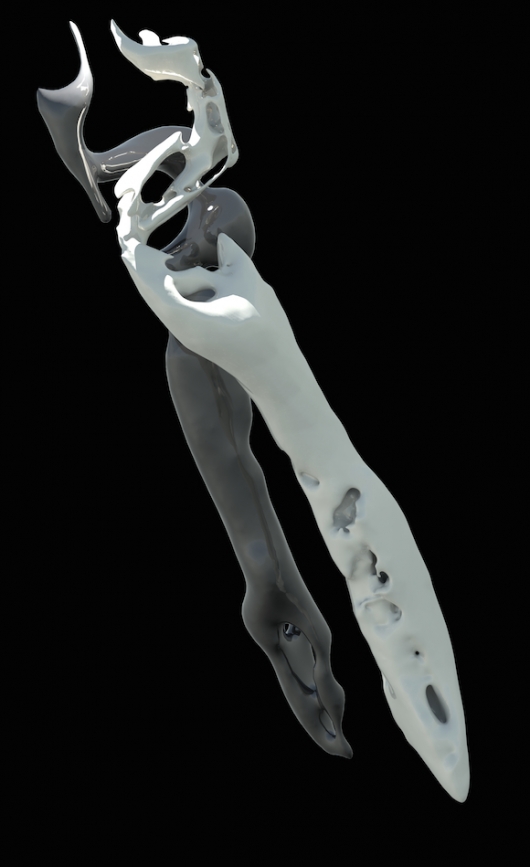Excerpt from Psychagogy: The Dance of the Fulcrum
Excerpts from Psychagogy: The Dance of the Fulcrum and Kroumatograph
The Dance of the Fulcrum is a performative excerpt and Kroumatograph is an installation component from a project in progress, Psychagogy. The overall work, meaning “the leading of souls” in ancient Greek, is both a transmedia song cycle and installation. The whole work explores musical experience and form as a function of both time and space. During the performative portion, as voice, piano, and electronics sound, two dancers— Maud Watel-Kazak and Tim Wood— engage in the art of sculpting music with the body. Using visual projections from a VR head-mounted display worn by one dancer and a real-time 3D spatial virtual drawing tool controlled by the other dancer, the two explore the space between music and sculpture, the actual and the virtual, the permanent and the ephemeral. In the second half, the audience is invited to explore a 3D-tracked environment brought alive with a both a grid of interacting standing waves and a grid different thermal and olfactory currents.
Through 3D-spatial trackers and sensors on the piano, moving strings and moving people algorithmically modulate the transmodal environment temporally in turn, uniting spatial and temporal elements into continuous, spatiotemporal musical expression.
Blending mythology, philosophy, and the avant-garde through algorithms:
Thematically, the whole work heavily explores social relationships and spatiotemperality through a poetic interpretation of the gift exchange between Apollo and Hermes in the Homeric Hymn to Hermes, particularly focusing on the relationship between the lyre (instrument of the temporal art: music) and caduceus (an instrument related to movement).
With respect to social relationships, the work examines such bonds as a means 1) to better "know thyself" through the contrast of the self and other and 2) to co-encourage ethical growth, as per Aristotle’s chapter on friendship in his Nicomanchaen Ethics. One way that this is expressed is through a spatially-tracked dance in which the spatial movements of the dancers have the potential to algorithmically generate more interesting musical changes to an electronic musical component. These changes depend on the proximity of the dancers, how well they respond to one another, and how ambitious they are in experimenting with their movements. As such, through this algorithm, the dancers are musically guided and incentivized to strengthen their bond to one another as well as to strengthen their individual abilities as dancers.
Spatiotemporal composition:
This new spatiotemporal approach to musical composition structures musical form cross-modally across the senses of sound, touch, kinesthesia/movement (of performers and spectators alike), vision, and olfaction. In part, the work is a dynamic, unfolding sound sculpture— a curated composite of standing wave harmonics, with each aggregate harmonic carrying its own frequency-beating polyrhythmic identifier. In this way, both pitch and rhythmic pattern are spatialized, creating a topology for participants to walk through and be guided through to experience musical variation and thus, musical form, depending on the trajectory of movement and physical displacement.
As such, the work serves as an ontological exploration of music— particularly investigating whether music can be separated from sound and whether, in the Platonic sense, it can be united with gymnastics.
Sponsored by the following UCSB entities: the Division of Humanities and Fine Arts, the Graduate Division, the Interdisciplinary Humanities Center, the Media Arts and Technology Program, the College of Creative Studies Music Composition, the College of Creative Studies Computing, the Department of Music, the Department of Theater and Dance, and the Classics Department.
